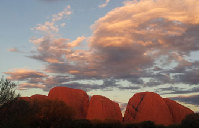Adventures in Australia
Updated: 2014-05-11 11:31
By Raymond Zhou (China Daily)
|
|||||||||||
It is a sandstone formation that looks like a cleanly cut tofu. It stands 348 meters high, with a circumference of 9.4 kilometers.
Legally you are still allowed to climb it, but your guide will do anything to talk you out of the idea, citing the number of deaths from falls and the mysterious deaths that occurred shortly after the climb. You see, the rock is sacred to the Anangu, the Aboriginal people of the area, who still perform certain rituals that even our guide is not supposed to know.
Anyway, the best way to marvel at this highly recognizable natural landmark of Australia is from a certain distance and at sunrise or sunset. I partook in both a dawn and a dusk tour.
The first and last rays of the sun seem to wave a magic wand over the rock, changing its colors from moment to moment as the light sifts through clouds of ever-changing density and form. There's a glow that almost seems to be from another world, something lifted from scenes of a fantasy film.
The day of my sunrise tour, just before the sun peeped from the horizon, there was a drizzle—a rare event, I was told, in this dry land. As a result of the sudden moisture, two parallel rainbows leapt from behind the rock, with a third struggling to emerge from the mist.
Sure, luck had something to do with it, but the magic of the location seemed to manifest pretty strongly.
Kata Tjuta, or Mount Olga as it was previously known before the name reverted to the Aboriginal term, is 25 km west of Uluru and seems to be a less distinguished cousin.
Related Stories
A night at the Sydney Opera 2014-05-09 14:40
Catching a wave in Australia 2014-04-06 11:17
Australia suggested to play larger role in Asian food security 2014-03-13 15:00
First Chinese New Year as Australians 2014-02-07 10:10
Australian Chinese zodiac launched for Lunar New Year 2014-01-30 09:11
Sydney offers largest New Year celebrations outside China 2014-01-28 15:45
Today's Top News
UN chief saddened by Turkey's mine tragedy
China-Russia gas deal to be inked
2 Chinese killed in Vietnam riots
Report adds steam to Abe's ambitions
China: US must be objective about Asia tensions
July elections in Thailand 'unlikely' amid crisis
274 dead in Turkey's worst-ever mine disaster
Russia to take on active role
Hot Topics
Lunar probe , China growth forecasts, Emission rules get tougher, China seen through 'colored lens', International board,
Editor's Picks

|

|

|

|

|

|







